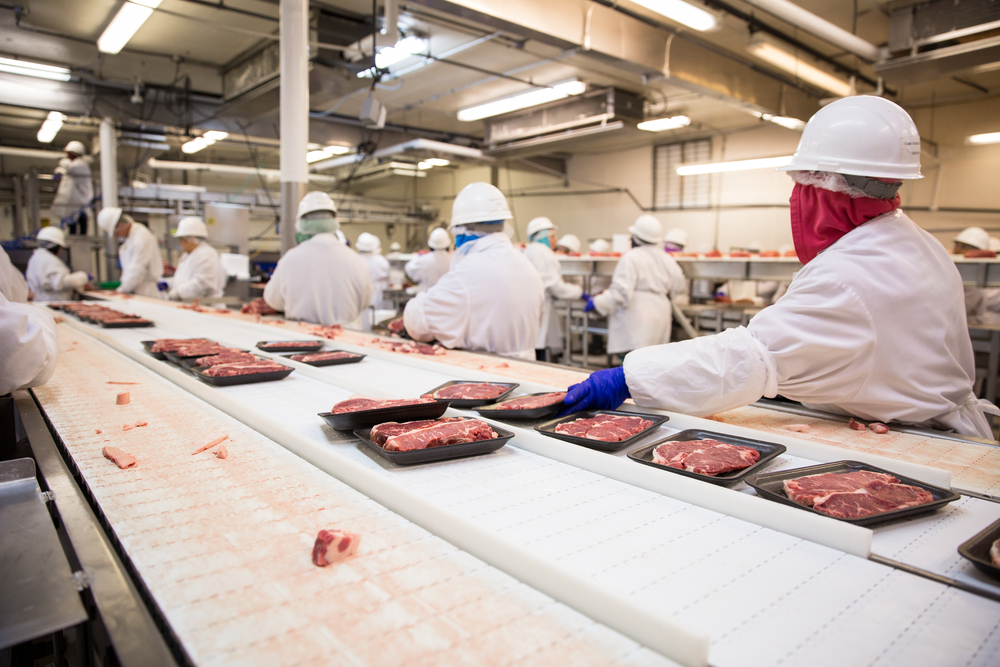The new estimations are nearly three times higher than previous ones.

While the COVID-19 pandemic is by no means a past crisis, a Congressional subcommittee has already been investigating the government’s response to the virus over the past year. This week, that subcommittee released the results of an investigation into meatpacking plants, and it found that the number of COVID-19 deaths and infections at many of the largest plants was much higher than previously reported—in some cases, several times higher.
It’s now known that meatpacking plants were major COVID-19 hotspots that spread the virus in rural and suburban communities far more than in similar towns without a plant. From federal inspectors put at risk to allegations of betting on infection numbers, meatpacking plants were chaos zones for months. They were uniquely situated to spread the virus: Workers have to work in close physical proximity for long hours, in indoor environments, and they often live together in company-provided housing. And the rapid consolidation of the meat industry has meant fewer, but larger, packing facilities. If one plant gets hit with a wave of COVID-19—and many did—that can infect a far greater number of workers than if the industry was more spread out.
The Select Subcommittee on the Coronavirus Crisis, chaired by James Clyburn (D-SC), this week released the results (and gave a hearing) of an investigation into meatpacking plants and the response from the meat corporations and from the various branches of the government involved in the COVID-19 crisis.
It has not been easy to find precise numbers on how many meatpacking plant workers were killed by COVID-19, let alone the number of confirmed infections, at any given site. Previous findings were full of contradictions. There’s been a lack of data provided by individual companies, as well as an inability (or unwillingness) for some to even keep proper track of infection figures. Even without that data, some studies have tried to link county-wide infection data with the presence and size of meatpacking plants, because workers at these plants could and did spread the virus into their local communities.
The Congressional subcommittee’s investigation led it to internal documents from the major players in American meatpacking—JBS, Tyson, Cargill, Smithfield and National Beef—which had previously not been public. It found about 59,000 positive cases at plants run by those companies between March 2020 and February 2021, with some plants having COVID-19 infection rates of around 50 percent. At least 269 deaths of plant workers can also be attributed to COVID-19, according to the subcommittee’s report.
The report makes a big deal about this being nearly three times higher than previous estimates. The previous estimate to which it is referring was 22,700 infections, and it came from the nonprofit Food & Environment Reporting Network (FERN). That FERN estimate, though, was not exactly an established fact; FERN made no secret of the fact that the estimate relied on inconsistent and almost certainly inaccurate reporting. According to FERN: “The data represented in these maps and charts is primarily collected from local news reports, with additional information gathered from state and local health authorities and, on occasion, from companies with outbreaks.”
In any case, the subcommittee also dug up some other disturbing evidence. According to the report: “An internal document from Tyson obtained by the Select Subcommittee shows that, on March 20, 2020, Tyson had not begun to conduct temperature checks, but it nonetheless was telling its workers: ‘It is vital that you come to work as planned, despite stories about ‘shelter in place.’’” Other documents revealed ineffective barriers created from plastic bags, dirty protective gear and statements from plant management that seem to disparage and resist efforts by the CDC to create a safer work environment.
There’s also a pretty good amount of bashing of the Trump administration’s handling of COVID-19 in meatpacking plants. According to the report: “Meanwhile, under the Trump Administration’s leadership, OSHA exercised minimal oversight and failed to protect worker safety. The Select Subcommittee learned during a staff briefing with OSHA that OSHA leadership made a ‘political decision’ not to issue a much needed regulatory standard requiring meatpacking companies to take specific steps to protect workers, limiting the universe of enforcement tools OSHA had at its disposal.”
It’s unclear what, if any, measures will be taken as a consequence of these findings. Clyburn, in his opening reports, said, “Meatpackers and other essential workers are the foundation of this country. We must get a full accounting of what happened to them during the coronavirus pandemic so we can learn from these failures to prevent a tragedy like this from ever happening again.”